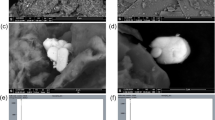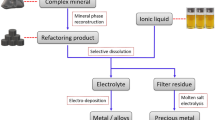Abstract
A mine and a Pb–Zn flotation plant operated in the Northeast of Brazil until 1993 and about 4.5 million tons of untreated tailings were disposed of in a dam. The chemical analyses of the tailings indicate that the major constituents are Fe, Si, Mg, and Ca. The toxic metals(oids) content are: Pb 1.3%, Zn 1.3%, Cu 135 mg/kg, Cd 127 mg/kg, and As 5 mg/kg. The mineralogical analysis shows that the major phase is composed of minerals from the amphibole group, more specifically cummingtonite, actinolite, and tremolite, which are all fibrous silicates defined as asbestos. Electron probe microanalysis and synchrotron-based X-ray absorption spectroscopy show sulfide mineral weathering. The Pb bearing compounds in the tailings are a mixture of cerussite and anglesite. The leaching tests show strong leaching of Cd, Pb, and Zn. It indicates they might be a relevant source of toxic metals and fibers that can have a significant effect on the local population’s health due to water and air contamination.










Similar content being viewed by others
Data availability
The authors confirm that the data supporting the findings of this study are available within the article and its Supplementary material. Raw data supporting the findings of the study are available from the correspondent author, upon reasonable request.
References
Alcalde J, Kelm U, Vergara D (2018) Historical assessment of metal recovery potential from old mine tailings: a study case for porphyry copper tailings. Chile, Miner Eng 127:334–338
Alves FEA, Bertolino LC, Mendes JC (2017) Characterization of Lead Mine Tailing in Boquira. Bahia State, Brazil, Anuário Do Instituto De Geociências - UFRJ 40:14–23 ((In Portuguese))
Behera SK, Ghosh CN, Mishra K, Mishra DP, Singh P, Mandal PK, Buragohain J, Sethi MK (2020) Utilisation of lead–zinc mill tailings and slag as paste backfill materials. Environ Earth Sci 79:389
Bertolino LC, Alves FEA, Mendes JC, Neumann R (2014) Preliminary mineralogical characterization of tailings samples from the former Boquira lead mine. Bahia, Comunicações Geológicas 101:965–968 ((In Portuguese))
Carvalho IG, Iyer SS, Tassinari CCG, Misi A (1997) Lead- and Sulfur-Isotope Investigations of the Boquira Sediment-Hosted Sulfide Deposit. Brazil, Int Geol Rev, Rev 39:97–106
da Luz AB, de Almeida SLM (1989) Manual de Usinas de Beneficiamento. CETEM-CNPq, In Portugaise, p 203
de Andrade Lima LRP, Bernardez LA (2017) Characterization of the soil contamination around the former primary lead smelter at Santo Amaro. Bahia, Brazil, Environ Earth Sci 76:470–481
de Andrade Lima LRP, Barbosa LAD, Vasconcelos CSA, Silva Junior JB (2009) Characterizaton and treatment of the Boquira Mine taillings, Procedings of the 23th Brazilian Meeting of Mineral Processing and Extractive Metallurgy, (In Portugaise)
de Andrade Lima LRP, Bernardez LA, dos Santos MG, Souza RC (2018) Remediation of clay soils contaminated with potentially toxic elements: the Santo Amaro lead smelter. Brazil, Case, Soil Sediment Contam 27:573–591
Földvári M (2011) Handbook of thermogravimetric system of minerals and its use in geological practice. Geological Institute of Hungary, Budapest
Gunter ME, Belluso E, Mottana A (2007) Amphiboles: environmental and health concerns. Rev Mineral Geochem 67:453–516
IBGE (2010) Censo Populacional do Brasil. Instituto Brasileiro de Geografia e Estatistica, Portugaise
Johnson RF (1962) Lead–Zinc deposits of the Boquira district state of Bahia, Brazil. Geol Service Bull 1111(A):1–33
Manceau A, Boisset MC, Sarret G, Hazemann JL, Mench M, Canbier P, Prost R (1996) Direct determination of lead speciation in contaminated soils by EXAFS spectroscopy. Environ Sci Technol 30:1540–1552
Nassiri O, Rhoujjati A, El Hachimi ML (2021) Contamination, sources and environmental risk assessment of heavy metals in water, sediment and soil around an abandoned Pb mine site in North East Morocco. Environ Earth Sci 80:96
Ravel B, Newville M (2005) ATHENA, ARTEMIS, HEPHAESTUS: data analysis for X-ray absorption spectroscopy using IFEFFIT. J Synchrotron Radiat 12:537–541
SEI (Superintendência de Estudos Econômicos e Sociais da Bahia), 2011, Estatística dos municípios baianos, Salvador, BA, 19:182. (In Portugaise)
U.S. EPA (1986) Toxicity characteristic leaching procedure, Appendix 1, Federal Register, 51(216).
Acknowledgements
Professor Nilson Francisquini Botelho and Dr. Jacqueline Menez Machado from the Laboratorio de Microssonda Eletronica, Brasília University (UNB, Brazil) are acknowledged for their valuable help in the EMPA analysis and data processing. Dr. Santiago J.A. Figueroa and the Brazilian Synchrotron Light Laboratory (LNLS, Brazil) are acknowledged for the XAS measurements and assistance in the data processing.
Funding
This study was supported by Conselho Nacional de Desenvolvimento Científco e Tecnológico (CNPq, Brazil), grant number 484094/2011–4 to Luiz Rogério Pinho de Andrade Lima and by Coordenação de Aperfeiçoamento de Pessoal de Nível Superior (CAPES, Brazil), PNPD 2013 to, Letícia Alonso Bernardez.
Author information
Authors and Affiliations
Contributions
LRPdAL: conceptualization, methodology, resources, sampling, data curation, formal analysis, writing—original draft, and writing—review and editing; LAB: methodology, data curation, analysis, and writing—review and editing.
Corresponding author
Ethics declarations
Conflict of interest
The authors declare that they have no known competing financial interests or personal relationships that could have appeared to influence the work reported in this paper.
Ethical approval
The authors confirm that ethical standards were addressed.
Consent to participate
The authors confirm the volunteer’s declaration of consent.
Additional information
Publisher's Note
Springer Nature remains neutral with regard to jurisdictional claims in published maps and institutional affiliations.
Supplementary Information
Below is the link to the electronic supplementary material.
Rights and permissions
Springer Nature or its licensor (e.g. a society or other partner) holds exclusive rights to this article under a publishing agreement with the author(s) or other rightsholder(s); author self-archiving of the accepted manuscript version of this article is solely governed by the terms of such publishing agreement and applicable law.
About this article
Cite this article
de Andrade Lima, L.R.P., Bernardez, L.A. Mineralogical and geochemical characterization of the tailings from the former lead–zinc flotation plant of Boquira mine, Brazil. Environ Earth Sci 82, 10 (2023). https://doi.org/10.1007/s12665-022-10678-1
Received:
Accepted:
Published:
DOI: https://doi.org/10.1007/s12665-022-10678-1




